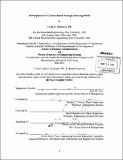| dc.contributor.advisor | Stephen C. Graves and David Simchi-Levi. | en_US |
| dc.contributor.author | Quiñonez, Carlo G. (Carlo Gabriel) | en_US |
| dc.contributor.other | Leaders for Global Operations Program. | en_US |
| dc.date.accessioned | 2013-09-24T19:37:09Z | |
| dc.date.available | 2013-09-24T19:37:09Z | |
| dc.date.copyright | 2013 | en_US |
| dc.date.issued | 2013 | en_US |
| dc.identifier.uri | http://hdl.handle.net/1721.1/81015 | |
| dc.description | Thesis (M.B.A.)--Massachusetts Institute of Technology, Sloan School of Management; and, (S.M.)--Massachusetts Institute of Technology, Engineering Systems Division; in conjunction with the Leaders for Global Operations Program at MIT, 2013. | en_US |
| dc.description | Cataloged from PDF version of thesis. | en_US |
| dc.description | Includes bibliographical references (p. 263-264). | en_US |
| dc.description.abstract | Strategic sourcing is a key factor in enhancing Nike's competitiveness and organizational and operational performances. As Nike faces increasing pressure to expand margins and reduce source base risk during a climate of volatile commodity prices and rising labor costs, it is imperative that Nike evolves its strategic sourcing mind-set and advance the decision-making processes. The motivation for the project is to evolve the current strategic sourcing approach at Nike by developing a more effective, efficient, and transparent sourcing process that can be applied throughout all Nike's brands and products. This is being accomplished by developing a criteria based model using Visual Basic and Microsoft Excel. The model takes into account important quantifiable variables such as total landed costs, country and factory compliance risk, and Nike's Manufacturing Index (factory performance measurement) to calculate a single output called the Risk Adjusted Total Landed Cost (RATLC). The scope of the project focuses on a specific Nike Brand apparel product classification (fleece) to be able to develop a functional pilot-scale model. The RATLC methodology and criteria based model is used to develop a case study comparing the sourcing decisions to the model output for fleece in the Fall 2011 Season. The model indicated that Nike had the potential to reduce total landed costs by $25 million and reduce the risk in the factory portfolio by working with factories with higher manufacturing index and lower country risk index scores. Other potential benefits include reduced duty costs, higher quality products, and reduced leadtimes. The model and methodology is able to help the sourcing team better understand the implications of total landed cost and supply chain risk on their sourcing decisions. With the tool, Nike will be able to understand and reduce the risks and costs associated with selecting a global network of sourcing factories. | en_US |
| dc.description.statementofresponsibility | by Carlo G. Quiñonez. | en_US |
| dc.format.extent | 264 p. | en_US |
| dc.language.iso | eng | en_US |
| dc.publisher | Massachusetts Institute of Technology | en_US |
| dc.rights | M.I.T. theses are protected by
copyright. They may be viewed from this source for any purpose, but
reproduction or distribution in any format is prohibited without written
permission. See provided URL for inquiries about permission. | en_US |
| dc.rights.uri | http://dspace.mit.edu/handle/1721.1/7582 | en_US |
| dc.subject | Sloan School of Management. | en_US |
| dc.subject | Engineering Systems Division. | en_US |
| dc.subject | Leaders for Global Operations Program. | en_US |
| dc.title | Development of a criteria based strategic sourcing model | en_US |
| dc.type | Thesis | en_US |
| dc.description.degree | S.M. | en_US |
| dc.description.degree | M.B.A. | en_US |
| dc.contributor.department | Leaders for Global Operations Program at MIT | en_US |
| dc.contributor.department | Massachusetts Institute of Technology. Engineering Systems Division | |
| dc.contributor.department | Sloan School of Management | |
| dc.identifier.oclc | 857790248 | en_US |
